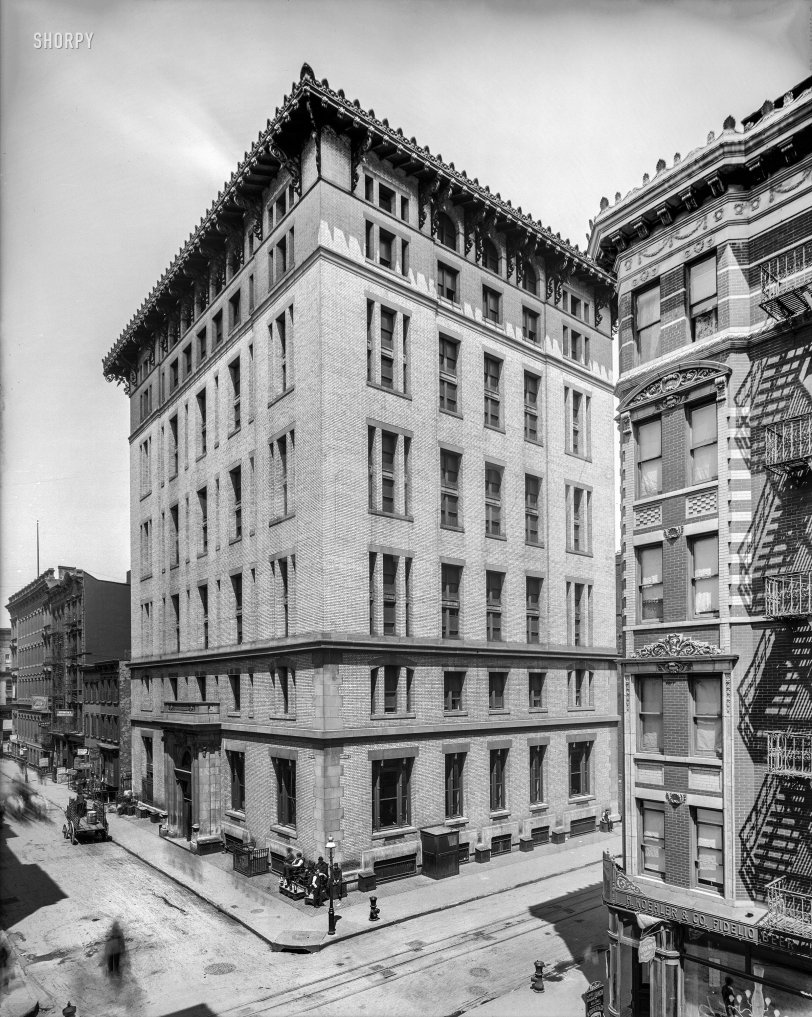


Framed or unframed, desk size to sofa size, printed by us in Arizona and Alabama since 2007. Explore now.
Shorpy is funded by you. Patreon contributors get an ad-free experience.
Learn more.

- Baldwin 62303
- Baldwin VO-1000
- Cold
- No expense spared
- Tough Guys
- Lost in Toyland
- And without gloves
- If I were a blindfolded time traveler
- Smoke Consumer Also Cooks
- Oh that stove!
- Possibly still there?
- What?!?
- $100 Reward
- Freeze Frame
- Texas Flyer wanted
- Just a Year Too Soon
- WWII -- Replacing men with women at the railroad crossing.
- Yes, Icing
- You kids drive me nuts!
- NOT An Easy Job
- I wonder
- Just add window boxes
- Icing Platform?
- Indiana Harbor Belt abides
- Freezing haze
- Corrections (for those who care)
- C&NW at Nelson
- Fallen Flags
- A dangerous job made worse
- Water Stop
Print Emporium
Ghost Hotel: 1905

"Mills House No. 2, Rivington Street, New York, N.Y." This "hostel for poor gentlemen," one of three erected by the banker Darius Ogden Mills as lodging houses for working-class men, contained 600 small rooms that rented for 20 cents a day. Our title honors the several ectoplasmic pedestrians whose shades inhabit this time exposure. 8x10 glass negative, Detroit Publishing Co. View full size.
My 20¢
The Mikco Building Materials Company now stands on that site at the corner of Rivington and Chrystie. The building on the far right occupies space that is now part of Sara D. Roosevelt Park. The two low buildings to the left are long gone, but the three beyond still survive.
Hydrant talk
1st hydrant: Water you up to?
2nd hydrant: I'm all plugged up today.
1st hydrant: Me too. Let us spray we get some relief soon.
2nd hydrant: I think I hear a fire truck - we're hosed!
1st hydrant: Last time that happened, my back got wrenched.
Not cable car tracks
What appear to be tracks for cable cars are actually tracks for electric cars which pick up their electricity from a bus bar inside that slotted conduit. The pick-up shoe was sometimes called a "plow"
Several cities, notably Washington D.C. and NYC, did not accept the overhead trolley wires. They insisted on the underground conduit pick-up. This is a problem when the street floods!
The square cast-iron covers every few feet are used for maintenance access, as explained here.
Coulda been a contender
No longer standing, but one of its two siblings is a landmark as of 2014.
And about the first one here.
The Battle with the Slum (1902)
By Jacob A. Riis (1849-1914). Excerpt: "Mr. Mills gave to the lodger a man’s chance, if he is poor. His room is small, but the bed for which he pays twenty cents is clean and good. Indeed, it is said that the spring in it was made by the man who made the springs for the five-dollar beds in the Waldorf-Astoria, and that it is just the same. However that may be, it is comfortable enough, as comfortable as any need have it in Bleecker Street or on Fifth Avenue. The guest at the Mills House has all the privileges the other has, except to while away the sunlit hours in his bed. Then he is expected to be out hustling. At nine o’clock his door is barred against him, and is not again opened until five in the afternoon. But there are smoking and writing rooms, and a library for his use; games if he chooses, baths when he feels like taking one, and a laundry where he may wash his own clothes if he has to save the pennies, as he likely has to. It is a good place to do it, too, for he can sleep comfortably and have two square meals a day for fifty cents all told. There is a restaurant in the basement where his dinner costs him fifteen cents."
Flowing Conversation
I wonder what those fire hydrants were saying to each other.
























On Shorpy:
Today’s Top 5